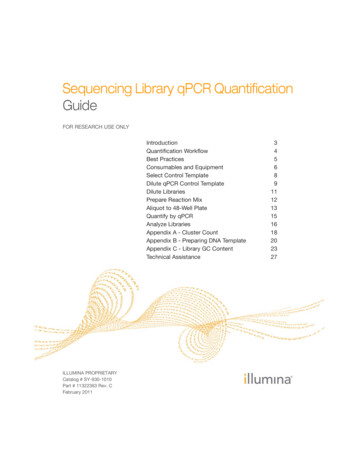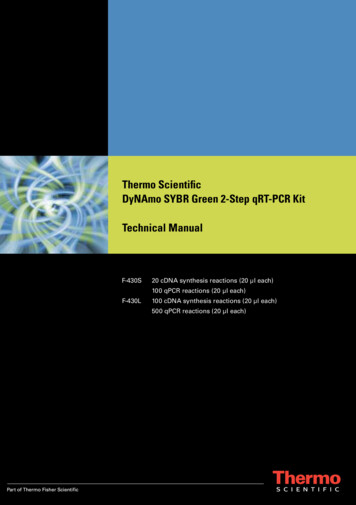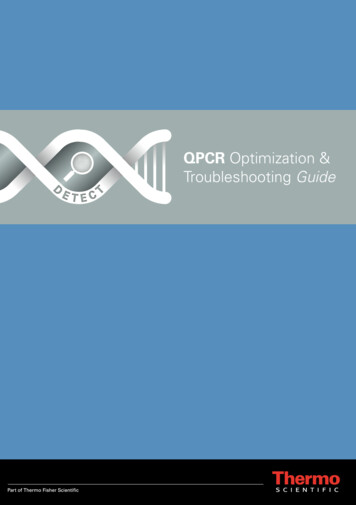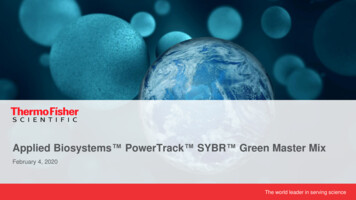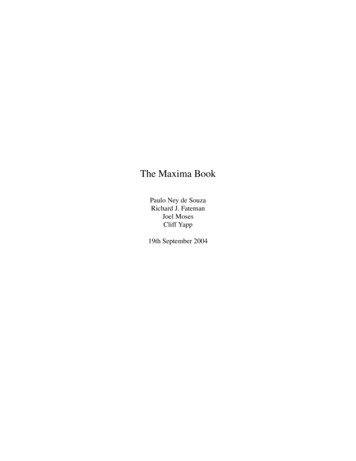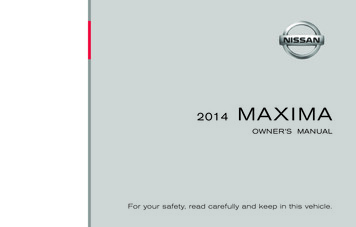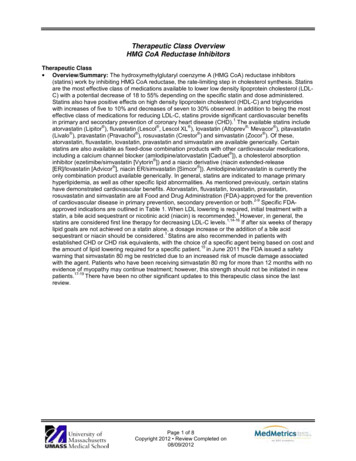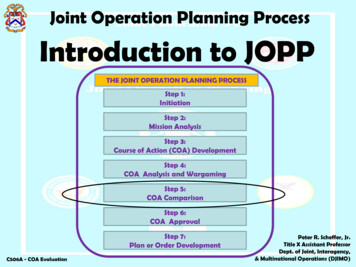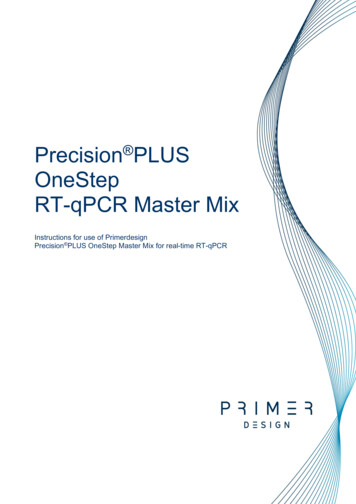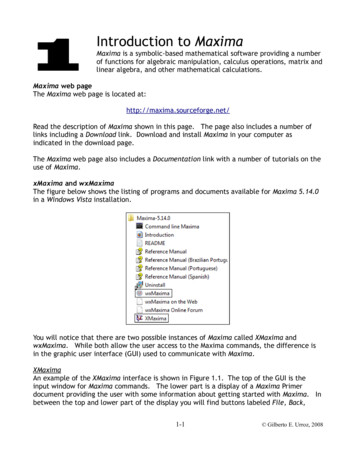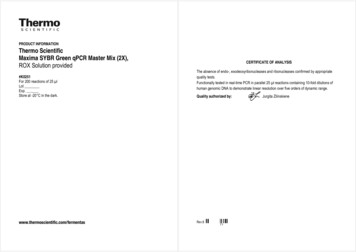
Transcription
PRODUCT INFORMATIONThermo ScientificMaxima SYBR Green qPCR Master Mix (2X),ROX Solution provided#K0251For 200 reactions of 25 µlLotExp. .Store at -20 C in the dark.www.thermoscientific.com/fermentasCERTIFICATE OF ANALYSISThe absence of endo-, exodeoxyribonucleases and ribonucleases confirmed by appropriatequality tests.Functionally tested in real-time PCR in parallel 25 µl reactions containing 10-fold dilutions ofhuman genomic DNA to demonstrate linear resolution over five orders of dynamic range.Quality authorized by:Rev.8} h Jurgita Zilinskiene
COMPONENTSComponentMaxima SYBR Green qPCR Master Mix (2X),no ROXROX Solution, 50 µMWater, nuclease-free#K0251for 200 rxnsof 25 µl#K0252for 1000 rxnsof 25 µl#K0253for 4000 rxnsof 25 µl2x1.25 ml10x1.25 ml4x12.5 ml50 µl2x1.25 ml250 µl10x1.25 ml1 ml2x30 mlSTORAGECONTENTSpageCOMPONENTS . 2STORAGE. 2DESCRIPTION. 2GUIDELINES TO ASSAY DESIGN . 3Templates . 3Primers . 3Necessary controls. 4IMPORTANT NOTES. 4PROTOCOL . 4Reaction set-up . 4Thermal cycling conditions . 5Optional steps . 5TROUBLESHOOTING . 6REFERENCE . 7NOTICES . 8Store at -20 C in the dark for long term storage or at 4 C for up to one month. Avoid multiplefreeze-thawing of ROX Solution.DESCRIPTIONThermo Scientific Maxima SYBR Green qPCR Master Mix (2X) is an universal ready-to-usesolution for quantitative real-time PCR and two-step real-time RT-PCR on most real-time PCRmachines. The master mix includes Maxima Hot Start Taq DNA polymerase and dNTPs in anoptimized PCR buffer. It contains SYBR Green I dye. ROX Solution is provided separately foruse with machines that require ROX. Maxima Hot Start Taq DNA polymerase in combinationwith an optimized buffer ensures PCR specificity and sensitivity. The SYBR Green Iintercalating dye allows for DNA detection and analysis without using sequence-specificprobes. dUTP is included in the mix for optional carryover contamination control using uracilDNA glycosylase (UDG). The use of Maxima SYBR Green qPCR Master Mix in real-time PCRensures reproducible, sensitive and specific quantification of genomic, plasmid, viral and cDNAtemplates.Maxima Hot Start Taq DNA Polymerase is a Taq DNA polymerase which has beenchemically modified by the addition of heat-labile blocking groups to amino acid residues. Theenzyme is inactive at room temperature, avoiding extension of non-specifically annealedprimers or primer dimers and providing higher specificity of DNA amplification. The enzymeprovides the convenience of reaction set up at room temperature.Maxima SYBR Green qPCR Buffer has been specifically optimized for qPCR analysis usingSYBR Green I. It contains both KCl and (NH4)2SO4 to provide high specificity of primerannealing. The buffer composition allows for PCR at a wide range of MgCl2 concentrations.Therefore, optimization of MgCl2 concentration in PCR is generally not necessary.SYBR Green I is a fluorescent intercalating dye which binds to the double stranded DNA andemits a fluorescent signal upon binding. In qPCR, DNA accumulates and fluorescent signalincreases proportionally to the DNA concentration. The excitation and emission maxima ofSYBR Green I are at 494 nm and 521 nm, respectively, which are compatible with the use onany real-time cycler.dUTP is included in the master mix to partially replace dTTP in the accumulated PCR product,allowing for the option to prevent carryover contamination between reactions (1). Uracil-DNAGlycosylase (UDG) pre-treatment of the reaction removes all dU-containing amplicons carriedover from previous reactions.Note. UDG is not included in the Maxima SYBR Green qPCR Master Mix, no ROX, and must be purchasedseparately.2
ROX Solution. ROX passive reference dye is supplied in a separate tube at 50 μM concentration.It can be added to a whole 2X master mix tube or to individual reaction mixture. ROX serves as aninternal reference for normalization of the SYBR Green I fluorescent signal when using machineswhich can detect ROX, e.g. from Applied Biosystems. ROX allows for correction of well-to-wellvariation due to pipetting inaccuracies and fluorescence fluctuations. ROX does not participate inPCR and has a different emission spectrum (the excitation/emission maxima are at 580 nm/621nm, respectively) compared to SYBR Green I. (Refer to a Table 1 to determine the recommendedamounts of ROX concentrations for a specific instrument you use). Avoid more than two G or C nucleotides in last five nucleotides at 3’-end to lower the risk ofnonspecific priming. Avoid secondary structures in the amplicon. Avoid primer self-complementarities, complementarities between the primers and directrepeats in a primer to prevent hairpin formation and primer dimerization. Optimal primer concentration is 0.3 μM for both primers in most cases. The concentration maybe optimized between 0.05 and 0.9 μM for individual primers and chosen by the lowest Ct forthe amplicon and the highest Ct for primer-dimer formation (if present).Table 1. Recommended amounts of ROX for a specific instrument.Necessary controlsInstrumentAmount of ROXper 25 μl reactionAmount of ROXper 1.25 ml of2X master mixFinal ROXconcentrationApplied Biosystems: 7300, 7900HT, StepOne ,0.05 μl5 μl100 nMStepOnePlus , ABI PRISM 7000 and 77000.05 μl5 μlApplied Biosystems: 750010 nM10X diluted*10X diluted*Stratagene: Mx3000P , Mx3005P , Mx4000 Bio-Rad: iCycler iQ, iQ5 and MyiQ , Opticon ,CFX 96, CFX 384Roche: LightCycler 480, LightCycler 2.0Not requiredNot requiredNot requiredCorbett: Rotor-Gene 3000, 6000Eppendorf: MasterCycler ep realplexCepheid: Smart Cycler * add 2 μl of ROX Solution to 18 μl of Water, nuclease-free, mix and use 0.05 μl for 25 μl qPCR reaction.GUIDELINES TO ASSAY DESIGNTemplatesDNA. Genomic DNA up to 500 ng and plasmid DNA up to 10 ng can be used in qPCR withMaxima SYBR Green qPCR Master Mix, no ROX.RNA. Template RNA for RT-qPCR must be free of DNA contamination. We recommend usage ofDNase I, RNase-free (#EN0521), to remove trace amounts of DNA from RNA preparations.Always perform an RT-minus control to confirm complete removal of DNA (see below). For twostep RT-qPCR, up to 5 μg of total RNA can be used for cDNA synthesis in the reversetranscription reaction. An aliquot of the first strand cDNA synthesis reaction is then transferred toanother tube as a template for qPCR.The volume of the cDNA added (from the RT reaction) should not exceed 10% of the final qPCRvolume.For first strand cDNA synthesis, we recommend using our Maxima First Strand cDNA synthesisKit for RT-qPCR, #K1641.Primers No template control (NTC) is important to assess for reagent contamination or primer-dimers.The NTC reaction contains all components except template DNA. Reverse Transcriptase Minus (RT-) control is important in all RT-qPCR experiments toassess for RNA sample contamination with genomic DNA. The control RT- reaction containsall components for RT-qPCR except the RT enzyme.IMPORTANT NOTES Reaction set-up is at room temperature as the master mix includes Maxima Hot Start Taq DNApolymerase. We recommend a reaction volume of 25 μl. Other reaction volumes may be used ifrecommended for a specific instrument. Preparation of a master mix, which includes all reaction components except template DNA,helps to avoid pipetting errors and is an essential step in real-time PCR. Start PCR cycling with an initial denaturation step of 10 min at 95 C to activate Maxima HotStart Taq DNA polymerase. Minimize exposure of Maxima SYBR Green qPCR Master Mix (2X), no ROX and ROX Solutionto light during handling to avoid loss of fluorescent signal intensity. Readjust the threshold value for analysis of every run. When using Bio-Rad iCycler iQ or MyiQ systems collect well factors at the beginning of eachexperiment using an external well factor plate according to the instrument manufacturer’srecommendations. Do not add fluorescein solution to the reaction mix. Well factors are used tocompensate for any system or pipetting variations.PROTOCOLReaction set-up1. Gently vortex and briefly centrifuge all solutions after thawing.2. Prepare a reaction master mix by adding the following components (except template DNA) foreach 25 μl reaction to a tube at room temperature:Primer design for qPCR is one of the most important factors to obtain efficient amplification and toavoid the formation of primer dimers.Use primer design software, such as PrimerExpress or Primer3 (frodo.wi.mit.edu) or followgeneral recommendations for PCR primer design below: GC content: 30-60%. Length: 18-30 nucleotides. Optimal amplicon length: 70-150 bp. Optimal melting temperature (Tm): 60 C. Differences in Tm of the two primers should notexceed 2 C.Maxima SYBR Green qPCR Master Mix (2X), no ROX*12.5 μlForward Primer0.3 μM**Reverse Primer0.3 μM**ROX Solution10 nM/ 100 nM***or not requiredTemplate DNA 500 ngWater, nuclease-freeto 25 μlTotal volume 25 μl* Provides a final concentration of 2.5 mM MgCl2.** A final primer concentration of 0.3 μM is optimal in most cases, but may be individually optimized in a rangeof 0.05 μM to 0.9 μM.*** see table 1 on p.3 for final concentration of ROX optimal for your instrument.34
3. Mix the master mix thoroughly and dispense appropriate volumes into PCR tubes or plates.4. Add template DNA ( 500 ng/reaction) to the individual PCR tubes or wells containing themaster mix.Note. For two-step RT-qPCR, the volume of the cDNA added from the RT reaction should notexceed 10% of the final PCR volume.5. Gently mix the reactions without creating bubbles (do not vortex). Centrifuge briefly if needed.Bubbles will interfere with fluorescence detection.6. Program the thermal cycler according to the recommendations below, place the samples in thecycler and start the program.Thermal cycling conditionsThermal cycling can be performed using a three-step or two-step cycling protocol.Three-step cycling protocolStepTemperature, C TimeNumber of cyclesOptional: UDG pre-treatment502 min1Initial denaturation9510 min1Denaturation9515 sAnnealing6030 sExtension7230 sTemperature, C TimeNumber of cyclesOptional: UDG pre-treatment502 min1Initial denaturation9510 min1Denaturation9515 sAnnealing/Extension6060 sNoamplificationcurve and noPCR productvisible on agel40Data acquisition should be performed during the extension step.Two-step cycling urve butPCR productvisibleon a gel40Data acquisition should be performed during the annealing/extension step.Optional steps UDG pre-treatment. If using carryover decontamination, include a 2 min UDG digestion step at50 C before the initial denaturation step. Melting curve analysis may be performed to verify the specificity and identity of the PCRproduct. Primer-dimers may occur during PCR if the primer design is not optimal. The dimersare distinguished from the specific product by a lower melting point. Agarose gel electrophoresis of PCR products. When designing a new assay it isrecommended to verify the PCR product specificity by gel electrophoresis, as meltingtemperatures of a specific product and primer-dimers may overlap depending on the sequencecomposition.Amplificationsignal innon-templatecontrolProblemPCRefficiency is 110%5Possible cause and solutionPCR inhibitors present in the reaction mixture.Re-purify your template DNA.Primer design is suboptimal.Verify your primer design, use reputable primer design programs or validatedpre-designed primers.RT-qPCR: inhibition by excess volume of the RT reaction.Volume of RT reaction product added to qPCR reaction should not exceed 10%of the total qPCR reaction volume.Pipetting error or missing reagent.Repeat the PCR reaction; check the concentrations of template and primers; ensureproper storage conditions of all reagents. Make new serial dilutions of template DNAor RNA.Degradation of primers.Check PCR primers for possible degradation on polyacrylamide gel.Annealing temperature is not optimal.Optimize the annealing temperature in 3 C increments.UDG present in PCR protocol with low annealing temperature.When performing UDG pre-treatment with conventional UDG, the temperatureduring PCR cycling should always be higher than 55 C. If annealingtemperatures must be lower than 55 C, use heat-labile UDG.qPCR instrument settings are incorrect.Check if instrument settings are correct (dye selection, reference dye, filters).Inactive fluorescence detection.Fluorescent detection should be activated and set at extension orannealing/extension step of the thermal cycling protocol.Instrument problems.Refer to the instrument manual for troubleshooting.DNA contamination of reagents. Follow general guidelines to avoid carry over contamination or includeUDG pre-treatment step at the beginning of PCR. Discard reagents and repeat with new reagents.RT-qPCR: RNA contaminated with genomic DNA.Design primers on intron/exon boundaries, treat RNA sample with DNaseI, RNAfree (#EN0521) prior to reverse transcription.Primer-dimers.Use melting curve analysis to identify primer-dimers by the lower meltingtemperature compared to amplicon. If presence of dimers is confirmed: Redesign your primers according to recommendations (see.p.3) or usevalidated pre-designed primers. Optimize annealing temperature by increasing in 3 C increments.Possible cause and solutionNon-specific products.Use melting curve analysis and gel electrophoresis to identify non specificamplicons.Optimize your primer design to avoid such artifacts or use validated predesigned primers.6
ProblemPossible cause and solutionPCR inhibitors present in a reaction mixture.Re-purify your template DNA.PCR conditions are suboptimal.PCRVerify the primer concentrations. Verify storage conditions of qPCR master mix.efficiency isPrimer design. 90%Verify your primer design, use primer design programs or validated predesigned primers. Avoid designing primers in regions with high DNA secondarystructure.Excessive amount of template.Do not exceed maximum recommended amounts of template DNA (500 ngDNA for 25 μl reaction).PoorSuboptimal amount of template.standardIncrease the amount of template, if possible.curveRT-qPCR: inhibition by excess volume of the RT reaction.Volume of RT reaction product added to qPCR reaction should not exceed 10%of the total qPCR reaction volume.Contamination of the thermal cycler.Perform decontamination of your real-time cycler according to the or calibration of the thermal cycler.intensityPerform calibration of the real-time cycler according to the supplier’sinstructions.NOTICES NOTICE TO PURCHASER: LIMITED LICENSEUse of this product is covered by one or more of the following US patents and corresponding patent claimsoutside the US: 6,127,155, 5,677,152 (claims 1 to 23 only), 5,773,258 (claims 1 and 6 only), 5,994,056,6,171,785. The purchase of this product includes a limited, non-transferable immunity from suit under theforegoing patent claims for using only this amount of product for the purchaser’s own internal research. Noright under any other patent claim and no right to perform commercial services of any kind, includingwithout limitation reporting the results of purchaser's activities for a fee or other commercial consideration,is conveyed expressly, by implication, or by estoppel. This product is for research use only. Diagnostic usesunder Roche patents require a separate license from Roche. Further information on purchasing licensesmay be obtained by contacting the Director of Licensing, Applied Biosystems, 850 Lincoln Centre Drive,Foster City, California. This product is provided under an agreement between Molecular Probes, Inc. and Thermo Fisher Scientific,Inc. and the manufacture, use, sale or import of this product is subject to one or more of U.S. Patents, andcorresponding international equivalents, owned by Molecular Probes, Inc. (a wholly-owned subsidiary ofInvitrogen Corp. The purchase of this product conveys to the buyer the non-transferable right to use thepurchased amount of the product and components of the product in research conducted by the buyer,where such research does not include testing, analysis or screening services for any third party in return forcompensation on a per test basis. The buyer cannot sell or otherwise transfer (a) this product (b) itscomponents or (c) materials made using this product or its components to a third party or otherwise usethis product or its components or materials made using this product or its components for CommercialPurposes. Commercial Purposes means any activity by a party for consideration and may include, but isnot limited to: (1) use of the product or its components in manufacturing; (2) use of the product or itscomponents to provide a service, information, or data; (3) use of the product or its components fortherapeutic, diagnostic or prophylactic purposes; or (4) resale of the product or its components, whether ornot such product or its components are resold for use in research. For information on purchasing a licenseto this product for purposes other than research, contact Molecular Probes, Inc., Business Development,29851 Willow Creek Road, Eugene, OR 97402, USA Tel: (541) 465-8300, Fax: (541) 335-0354. The purchase of this product includes a limited, nontransferable license, under specific claims of one ormore U.S. patents owned by the University of Utah Research Foundation and/or Idaho Technology, Inc., touse only the enclosed amount of product according to the specified protocols. No right is conveyed,expressly, by implication, or by estoppel, to use any instrument or system under any claim of such U.S.patent(s), other than for the amount of product contained herein.REFERENCE1. Longo, M.C., et al., Use of uracil DNA glycosylase to control carryover contamination inpolymerase chain reactions, Gene, 93, 125-128, 1990.7 NOTICE TO PURCHASER: LIMITED LICENSE. Use of this product in a passive reference method iscovered by the following U.S. Patent: 5,928,907 (claim numbers 12-24, 27-28) and corresponding patentclaims outside the US. The purchase of this product includes a limited, non-transferable immunity from suitunder the foregoing patent claims for using only this amount of product in a passive reference method forthe purchaser’s own internal research. No right under any other patent claim and no right to performcommercial services of any kind, including without limitation reporting the results of purchaser's activitiesfor a fee or other commercial consideration, is conveyed expressly, by implication, or by estoppel. Thisproduct is for research use only. Further information on purchasing licenses may be obtained by contactingthe Director of Licensing, Applied Biosystems, 850 Lincoln Centre Drive, Foster City, California 94404,USA.8
PRODUCT USE LIMITATIONThis product is developed, designed and sold exclusively for research purposes and in vitro use only. Theproduct was not tested for use in diagnostics or for drug development, nor is it suitable for administration tohumans or animals.Please refer to www.thermoscientific.com/fermentas for Material Safety Data Sheet of the product. 2011 Thermo Fisher Scientific Inc. All rights reserved. SYBR is a registered trademark of Molecular Probes,Inc. ABI PRISM and StepOnePlus are registered trademarks of Applied Biosystems. StepOne andPrimerExpress are registered trademarks of Applera Corporation. Mx3000P, Mx3005P are registeredtrademarks and Mx4000 is trademark of Stratagene, Inc. iCycler iQ is a registered trademark and iQ5, MyiQ aretrademarks of Bio-Rad Laboratories, Inc. LightCycler is a registered trademark of Roche Diagnostics GmbH.Rotor-Gene is a registered trademark of Corbett Life Science. MasterCycler is a registered trademark ofEppendorf AG. SmartCycler is a registered trademark of Cepheid. All other trademarks are the property ofThermo Fisher Scientific Inc. and its subsidiaries.9
LightCycler 480, LightCycler 2.0 Reaction set-up is at room temperature as the master mix includes Maxima Hot Start . Taq. DNA. Not required . Not required Not required . Eppendorf: MasterCycler ep . Corbett: Rotor-Gene 3000, 6000 We recommend a reaction volume of 25 μ l. Other reaction volumes may be used if. Cepheid: Smart Cycler
